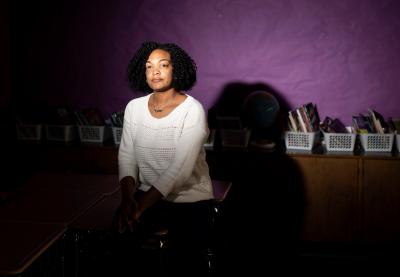We launched our Teaching Hard History initiative in February 2018 to help fill the void in popular textbooks and insufficient state standards for teaching about slavery. A critical component of this project has been engaging with educators who teach this history well. As part of our series highlighting educator voices, we sought out Black teachers who teach in predominately Black or all-Black settings to ask how they approach this topic.
Meet the five exemplary educators who told us about their experiences: Ayesha Al-Shabazz, a second-grade teacher in Tuscaloosa, Alabama; Patrick Harris, a fifth- and sixth-grade ELA teacher in Washington, D.C.; Tamara Spears, a middle school social studies teacher in Brooklyn, New York; Jordan Lanfair, a seventh- and eighth-grade ELA teacher in Chicago, Illinois; and LaKeshia Myers, a school support teacher and former high school U.S. history and government teacher in Milwaukee, Wisconsin.
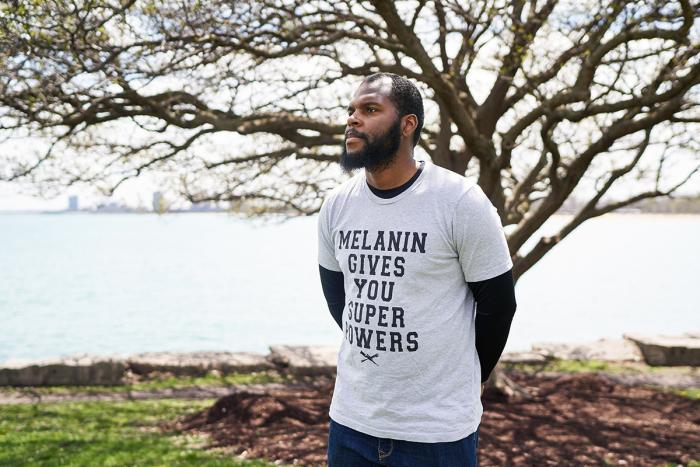
How has the way you were taught about slavery affected the way you teach about it?
Tamara: I do not remember specifically learning about slavery. I remember learning about Harriet Tubman, Frederick Douglass, and then you learn about Martin Luther King. Probably in college is where I most remember, in my own studies, trying to figure it out.
So, the way that affects me is I try to give [my students] as much as I can, relate it to topics, attach it to pre-colonization, pre-slavery, so that they have some kind of context. … When they get to the civil rights movement, it’s not, “OK, this is the first time people are trying to get their civil rights.” It’s a legacy that happened.
Ayesha: I don’t really remember being taught about slavery in school, either.
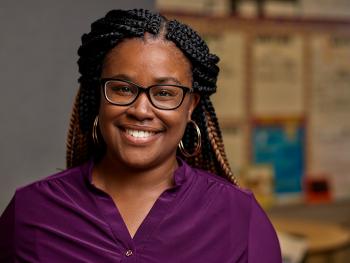
That’s why I really make sure to inform my second-graders about the pre-colonization as well. And they’re able to grasp and understand that information—that we were not just slaves. … I actually start my Black History Month unit with that information, and then we move on to slavery and the civil rights movement. So, I go in that chronological order.
Jordan: I got the “Black history started with Martin Luther King” elementary education until high school. Then it was slave revolts … the full Black experience. ...
[Now] my class always starts around Columbus Day, with slavery, with “What was the slave trade?” And, of course, getting into [Columbus]: He committed massacres. He introduced the slave trade. So, “Why do we have this holiday?” ... “Why do we have President’s Day?” “Should we celebrate all the presidents?” “Why do we have this?” Trying to infuse more history into everyday life, so that when Black History does come around, and inevitably the school is like, “Hey, let’s talk about George Washington Carver this week!” we have a bit more radical edge to it as well.
Patrick: I do remember learning about Harriet Tubman, mainly because we recited the poem by Eloise Greenfield. But as it pertains to learning or knowing about slavery, the way in which I was taught in school was that you just kind of knew—or you were told—Black people were slaves. You never really got the opportunity to ask why. That was never a part of the lesson.
It was sort of like what they call the banking method, if you will. You know, it’s like, “We’re slaves and that was just the reality of the situation.” When you learn that people who look like you belonged to people who didn’t look like you, that is emotionally traumatizing. So the fact that we didn’t get the opportunity to ask why or didn’t get an opportunity to investigate why in our educational space really pushed me to make that a core, essential question for my students now.
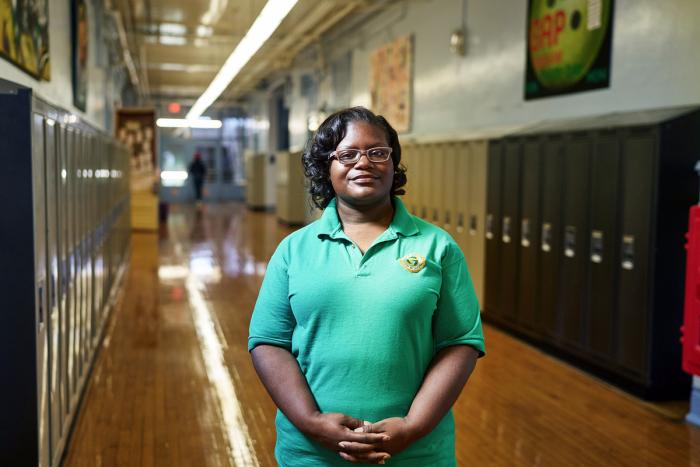
Getting to the foundation for slavery is core to what we’re doing with our Teaching Hard History initiative. How do you get at that core in your teaching?
Jordan: [Th]e thing that, in learning it and teaching it, I’ve tried to get across: Whenever the kids ask, “How did we get to be as rich as we are?” I’m like, “We had free labor.” You can’t get around anything about our current system without acknowledging that we had hundreds of years of free labor. And that labor [was free] because of white supremacy—which was enabled by slavery.
Tamara: What I actually started with this year ... was what happened in the summer with Charlottesville and the Confederate statues. The kids were like, “Well, I don’t really see the point. Why don’t we just keep them up?” [That’s] because they didn’t have that connection of what these statues meant and how white supremacy can permeate all of their lives.
Patrick: Our second unit was studying the social construction of race and kind of breaking down what race actually is, so [“What is race?”] can be an essential question for every single unit that follows afterwards. So, if we are going to relate white supremacy to everything, then we have to break down whiteness, and we have to break down race and what that means to them … so that they have a foundation.
Teachers are human beings, and we’re people who feel emotions and we are learning right alongside our students every single day.
As you’ve gained experience as an educator, how has your teaching about slavery evolved?
LaKeshia: I take it really seriously, keeping up with literature and making sure that you look at the constructs of how you teach history. … [A]ctually going the extra mile and talking about white privilege and what that is, what it looks like, how to look at concepts of silent rage versus outward expressions of rage that you see. Like what happened in Charlottesville.
I think the students appreciate it more, and I think they actually get a deeper understanding of it when you tell them the truth. They’re like, “Oh. Nobody ever explained this to me this way.”
Tamara: Here in New York City, I felt like (maybe around my third or fourth year) it was important to make sure the kids had an idea of what the North was doing to perpetuate slavery. Because they automatically think, “Oh, it was in the South, so it was only the Southerners that were bad.” So, I do spend probably more [time] than is supposed to be spent—a lot of time—talking about New York City in particular. What was our involvement? And what was happening here in Brooklyn? We had a large population. We had the largest population of slaves in the North at the time. …
I also do a lot of document analysis because sometimes they get it when we use movies and things like that. But I try to give them primary sources so that they can really see what was happening. I had one kid say, “I saw it in the movie, it felt real, but hearing their own voices makes me really understand what they felt.” To me, that was gold because it was the point of them really seeing what was happening at the time: What did those people feel?
Patrick: [T]his is my first year of teaching slavery. ... As I was designing this unit ... I wanted to ensure that they knew that slaves were actually people. And I wanted to obviously use primary sources to help aid [students] in their process. So, they each had interviews of freed slaves from a project. Their job was to design an art project basically telling the story of that freed slave— who they were as a person and as an individual, and then relate the history that they learned, now having the lens that they’ve kind of gotten to know their “partner,” per se, in the work.
Jordan: I’m very much focused on “Slaves are people,” but also, I’m very clear with my seventh- and eighth-graders: Slavery was brutal. … I’ve been very honest with them. I think our ancestors are some of the coolest people on the planet. Like, when you think about how many people died, when you think about how much it took to make it...
So, we do a lot of oral history, trying to bring that in. “Interview your grandparents. What do they remember? What stories do you have about your family?” A lot of them bring back stuff like, “I didn’t know that my great-grandma was a sharecropper,” or “We have this picture.”
I’m like, “You’re not that far removed.” So, we try to attack it from, “What was going on with your family?”—especially since we’re in Chicago, we’re one of the big spots for the Great Migration. And a lot of people are like, “Yeah, my grandpa just came home and was like, ‘We gotta go,’ and never really explained why.”
Tamara: [M]y great-grandfather was a sharecropper. He was from South Carolina, and I give them that story when we’re talking about the Great Migration, but making that connection between [the] Great Migration and slavery, and why was that such a big deal for these ex-slaves to pick up and go and try to make a better way for themselves. … Everyone was moving, but really understanding what was the difference for ex-slaves moving than, say, immigrants moving.
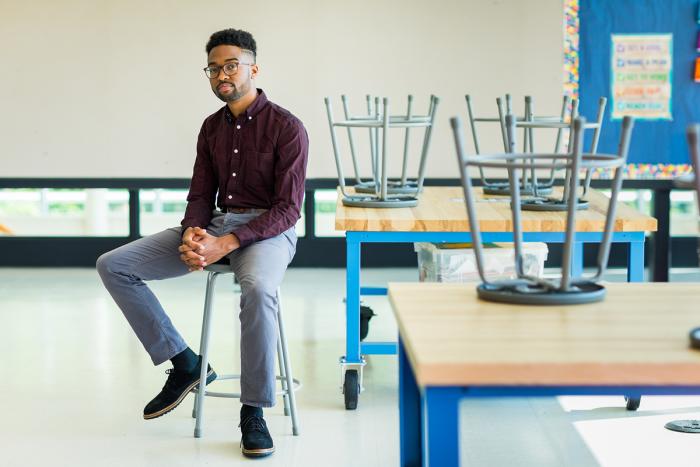
How do your students’ identities as Black children affect how you approach the subject matter?
Tamara: A lot of the students, when we first start the slavery unit, they’re like, “Ah, man. Why do we have to always talk about the fact that we were slaves?” And I ask them, “When did you learn about slavery?” So, they give me a little piecemeal. ... I do a whole pre-unit, like a mini-unit, on what race is and discuss their race because a lot of them have ... a very different viewpoint on what race is. … So, for me, [I] validate any feeling that they may have, either negative or positive. ...
I feel, as their Black teacher, that I have to give them these certain things to make sure that they understand the value of themselves beyond the start in this country as slaves. Also, I was thinking, reminding them that not every single Black person was a slave. I let them know, “It’s a very complicated topic, and we’re gonna delve into it. You’ll have these different feelings, but let’s push forward and learn about it.”
Ayesha: I feel a little more free with my Black students because I am a Black person and all of my students are Black. … There’s not a sense of awkwardness. … I feel a little more free to discuss things that maybe they have gone through because a lot of them know what racism is, and they know what a racist is at this age. So, a lot of them, they might share some of their experiences, I might share some of my experiences, and we can do that openly and freely without feeling judged or awkward.
LaKeshia: That’s kind of how I felt, and my students were always asking questions about “Well, how was this legal? Why was this going on?” So, I can give them the how and the why about different situations … explaining how the Constitution was actually set up, why it was there, and how slaves played into that.
Then, with me living in Wisconsin—as Tamara said, being up North people always think, “The South was just so bad. It was all them.” I’m like, “No. We had a guy here in Wisconsin that had to sue, to the State Supreme Court, to actually get his right to vote. So, that’s how we played a part in it. People could bring folks from other places and still hold them in bondage here, even in the North.”
Jordan: There’s this great sense of betrayal my kids have when we actually start getting into it. See, because I have them as eighth-graders, they’re like, “Why didn’t I learn this before?” Reading A-Z actually has a pretty good book on Frederick Douglass, so we get into Frederick Douglass and what his role was, and how he really had to petition Abraham Lincoln and lobby and push for [abolition].
I think that’s really the thing that stands out to me, is they’re always so angry that it took us so long to get to a point where we would talk in depth. Then, because I have Black kids and I work in a Black school, this year my kids were also very hotep-ish because they had a hotep history teacher. They said that slavery came because white people were made in a lab, and they were allowed to rule for a few years. ... So, we had to actually unlearn a lot of stuff. So, in some other schools, it’s been unlearning white privilege, and this year it was new in that we were unlearning hotepery.*
Patrick: I teach at a private school. All boys, all Black boys. It’s a tuition-free private school, and many of our boys are going off to private school for middle school as well, where they will be in predominantly white environments because we’re one of the only—one of two, maybe—predominantly Black private schools in the area. So, having Black boys and being a Black man myself, I just have a strong sense of urgency.
I’ve been really serious about the history that they learn and the type of questions that they ask, and using the slavery unit and the social construction of race unit to really build the lens. Because it’s the lens that I think is most important. That is more important than the content, really; that we want to get them asking better questions about the things that they learn about.

When you do have white students in your class, how does your teaching shift, if at all?
Jordan: Oh, they get it. ... I mean, we talked about white privilege. (I was the only Black staff member at a predominantly white school, and that was like, “It’s not my job to make you feel good.” That was what I always kind of told them, but I bathed in white tears a lot at that job. That’s why my skin stays glorious, though.)
[In class] we looked at a bunch of different Martin Luther King speeches, so that was a really great entry because everyone looks at “I Have a Dream,” and they’re like, “Yeah. See, he had a …” It was like, “Yeah, OK, well, let’s look at what the ‘Letter From Birmingham Jail’ actually says.” ...
So I gave students some doubt about what they thought they knew, and then we started trying to unpack where that doubt came from. ... “OK, the school that’s over in the suburbs, what do they have versus what we have? Even our school, what do we have versus what a school in a prominently Black neighborhood would have?”
So, kind of getting it, but making it very practical for them. And [reminding them] that they as individuals—especially because they are kids—“No, you haven’t done anything in your 13 years of life that’s led to institutional racism. But you could. You’re just benefiting from it.” Getting them to see that.
LaKeshia: The conversation also got my students, the white ones, to start thinking about how they can utilize their white privilege to transform some of those things that are normal. ... [L]ike he said, the benefits of privilege. “You’re benefiting from it. You may not have done anything directly to get this, but you can use your privilege to point out when other people have wronged your classmates or have been egregious in some type of way, and give voice to it so that you can show that you understand them.” … So, trying to give them the license to be OK with being the change, if you will.
Ayesha: First of all, I don’t change the way that I teach. Then I have noticed that the white children are always—you know, these are the babies—they’re always more ready to think, “Well, that’s not fair” or “Why did they do that?”
So, they will speak up more than the Black students will, and I don’t know if it’s because they feel like they have to say something because they’re surrounded by a bunch of Black kids. I don’t know, but I do ask them a lot of “How does that make you feel? How would you feel if that happened to you or someone in your family?” So I have noticed that the white students tend to speak up a little bit more when we talk about slavery.
What advice would you give to teachers who are not Black who shy away from really digging into this history with Black students?
Patrick: Please, no simulations. Please, please. I cannot. No shade, but no Teachers Pay Teachers or any sort of things like that. Do the work of digging into the history. [And] try to find as many Black voices to lean on so that you are not presented as an authority figure in this particular unit, if you will. I think you have to really be intentional about lifting up and elevating Black people and Black culture and Black voices so that students can really grasp that, and not through a white lens.
Tamara: They have to sit and deal with their own emotions, whether that be white guilt or white denial or somewhere in between, and understand the real foundation of slavery in building this country. And ... putting Black voices first. And understanding, yes, we celebrate Abraham Lincoln so much, but the people were freeing themselves as well. And really thinking about the agency that Black people have, and not taking it away.
For those teachers who are neither Black nor white, I would say first grapple with any anti-blackness that may exist within your own spaces. It can influence the way you teach slavery. Combat that, and be sure to also center Black voices and bring in any additional viewpoints or connections you can make with your people's experiences.
What advice would you give to your fellow Black educators?
LaKeshia: Whatever population of students you have, don’t do them the grave disservice of glossing over that part of history. It was real. It happened. And you can give onus and ownership to those people’s story, and the connection that it has to the condition of our society today. ... Why do you need to not teach your own history to students who look like you? You’re the best person to teach them. You’ve lived certain experiences. You can empathize and understand. So do yourself a favor and do the students a favor by being unapologetic about who you are and what the history is, and teach the truth.
Patrick: One thing I think that people don’t really think about is that teachers are human beings, and we’re people who feel emotions and we are learning right alongside our students every single day. Even though we’re at the front of the classroom facilitating, while I’m teaching history or while I’m reading this or doing my prep work or reviewing this lesson, I still feel those same emotions that my students feel. I’m not silent. I’m not numb to this. And it’s important that we don’t stay numb in this as we continue to teach slavery. So I would just say know your history and do your work because it’s important work that we do.
Tamara: If you’re not sure about the exact history, spend the summer learning up. Be so familiar with the content that you can just go and work off of questioning and dealing with the emotions that will come up. And for yourself ... let [your students] know, like Patrick said, “You know, I’m feeling something behind this when I read it. Let’s see. What do you feel when you read this?” …
Ayesha: I would also say don’t just stop with slavery, or don’t just start with slavery. A couple of months ago ... one of my colleagues was in charge of doing a presentation for the Black History Month program. She was dancing, and she asked me for some ideas that she could incorporate into the dance. She’s telling me that she was going to start the dance with the children mimicking picking cotton and things like that. So I pretty much told her, “Slavery is a part of our history, but that’s not our only history. I think you should probably take it back to the roots of our history.” She did listen to that advice and began the presentation with an African dance.
I would say just, on an elementary level, don’t shy away from things, but just be mindful of what type of message you’re getting across to the children.
Jordan: Be blackity, Black, blackity, blackity Black. I mean, our ancestors were forced to be quiet for so long, and [they didn’t] have that luxury.
I’m sure everyone’s heard people who are like, “I’m past slave movies.” Yeah, it’s hard, but it’s so improbable how many [enslaved people] made it to the North. The fact that we can have this teleconference is improbable. Our kids sitting in class is improbable, and I think they need to know that. That there were people who dreamed one day that their grandkids would be able to go to a public school, would be able to grow up and vote, and the only way we really give them that reality—and both that blessing and burden—is teaching it and teaching it well.
We are our ancestors’ wildest dreams, but we don’t know that unless we know what our ancestors went through. So that’s really what I want other teachers to know. Like everyone said, do your best, learn your facts and all that, but remember that, without the sheer toughness and tenacity and community that they have put together, we aren’t here doing this. So do it right.
Bell is the senior editor for Teaching Tolerance.
*Hotep is an Egyptian term that means “to be at peace,” and the word itself derives from Imhotep. The term is often used to describe a Black person who espouses inaccurate African or African-American history. The reference to white people being made in a lab goes back to the story of Yakub. According to the Nation of Islam, a scientist named Yakub who lived thousands of years ago created white people as an experiment.

Want to take these teachers’ advice? Educate yourself on the deep and complex history of American slavery and how it shaped the United States’ institutions and beliefs about race.
